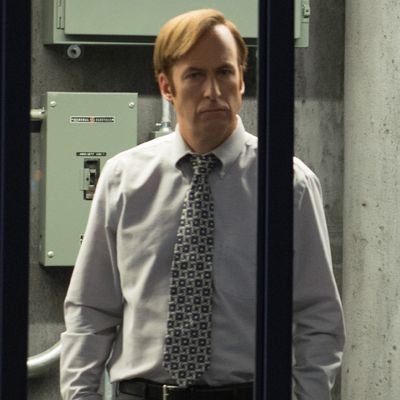
It’s not enough to say that Better Call Saul is not Breaking Bad. It’s more like the anti–Breaking Bad, even though it’s set further back on Bad’s timeline, shares its modern New Mexico setting, and features many of the same characters. Where Vince Gilligan’s original AMC crime drama was plot-driven to a fault, withholding and then surprise-injecting regular dopamine hits of What’s next?, the follow-up is more relaxed: easing into long, carefully shaped scenes with theatrically neat beginnings, middles, and ends, always favoring atmosphere, visual texture, and sad-sack characterization. The plot thickens and simmers but it has yet to boil over. Will it ever?
It probably doesn’t have to, thanks to the show’s embrace of prequel-ness. We know the title character — Bob Odenkirk’s con artist and lawyer, referred to here as “Slippin” Jimmy” McGill — is fated to break bad, enacting a mopey, scaled-down version of Bad hero Walter White’s long slide into vicious monomania. We grew improbably fond of Jimmy/Saul on Breaking Bad, so we know he can’t die here; the show even gives us occasional flash-forwards to a post-Bad Saul working at a mall Cinnabon, as if to drive the point home. Other recurring characters are likewise “protected”: the ex-cop turned underworld fixer Mike Ehrmantraut (Jonathan Banks), the volcanically hotheaded drug dealer Tuco Salamanca (Raymond Cruz), and his uncle Hector (Mark Margolis), who is disabled in Breaking Bad but appeared at the end of this week’s episode in comparatively decent health.
But the show’s other key players could slough off their mortal coils at any moment: Tuco’s disloyal lieutenant Ignacio “Nacho” Varga (Michael Mando); Jimmy’s law-firm colleague and sometime squeeze Kim Wexler (Rhea Seehorn); Jimmy’s disapproving older brother Chuck (Michael McKean), who suffers from electromagnetic hypersensitivity. The overall effect is curiously like watching Boardwalk Empire, Deadwood , or some other series that mixes historical personages and invented characters: You enjoy watching Al Capone or Calamity Jane chew scenery, secure in the knowledge that the writers aren’t going to go all ahistorical on you, while tensing up whenever a Chalky White or Joanie Stubbs gets threatened.
All this allows Saul to work in a different key (minor) and a different mode (something like mid-period Elmore Leonard or The Friends of Eddie Coyle; or on television, Justified or Terriers or The Rockford Files). Characters are periodically threatened with fatal violence, but it’s more about what it does to them psychologically or the character shadings the threat reveals than the possibility that they might die — take when Jimmy fast-talks his way out of an execution or Mike declines to kill Tuco at Nacho’s urging, and instead contrives an altercation that sends Tuco to prison on assault and weapons charges (putting him out of commission until the Breaking Bad timeline, presumably). A lot of the show is dedicated problem-solving, not on the high-octane level that we used to see Walter White operate on, but on a more earthbound plane.
If anything, Gilligan, series co-creator Peter Gould (a Bad alumnus), and their collaborators have turned the heat down in season two. Any given episode is likely to contain maybe eight to ten full scenes and a montage or two, and these always go on a bit longer than you expect, longer than TV drama’s norm — three minutes, five, more — the better to let you join the characters in whatever room they happen to inhabit, examine every reaction and spoken word, and notice their positions in frames that are often comprised of half to three-quarters darkness.
Money, status, satisfaction, and the possibility of behaving ethically in an unethical world are always at the heart of the characters’ choices. Jimmy wants his brother’s respect and to be able to look at himself in the mirror without guilt, but he also wants fame and money. The legitimate do-gooder side of him is forever in conflict with the con-man side, which flares up in a manner akin to an alcoholic’s urge to drink (Chuck’s comparison). Mike wants to protect his daughter-in-law and granddaughter and make a new start for himself with the brutal skill set that’s all he has left after leaving the force. Mike’s deadpan interactions with the local underworld (he’s like a cross between Droopy the Dog and the Terminator) alternate with Jimmy’s adventures in the white-collar world of Albuquerque civil law. The bifurcation is often jarring and a little weird, as if somebody had spliced together episodes of Breaking Bad and Thirtysomething.
But it works because we have such affection for this world and these characters, and because every character struggle is ultimately about self-discovery, affirmation, and the unrelenting difficulty of surviving in a brutal, 21st-century economy. Even if you don’t have to kill somebody to make rent, you might have to crawl around in a dumpster looking for documents or travel to Texas to solicit class-action-lawsuit clients on a retirement-home bus. At this point the show feels more like an assured and eccentric spinoff than an entirely separate achievement, but we’re only halfway through season two, and the patience evidenced by Gilligan and company suggests it would be unwise to assume we know what cards the writers have up their sleeve, much less how they will play them.


